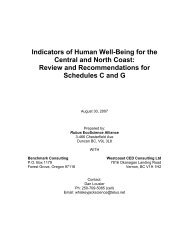Final report - Integrated Land Management Bureau
Final report - Integrated Land Management Bureau
Final report - Integrated Land Management Bureau
Create successful ePaper yourself
Turn your PDF publications into a flip-book with our unique Google optimized e-Paper software.
3.6 Major Ports<br />
PRINCE RUPERT<br />
Strengths<br />
• Closest North American port to Asia; 3-4 days<br />
closer than LA and 1.5-2 days closer than<br />
Vancouver/Seattle, with fuel cost savings and<br />
GHG emissions environmental benefits<br />
• Efficient rail connection to American mid-west<br />
and south to Mexico<br />
• <strong>Land</strong>s for growth<br />
• Efficient inter-modal container terminal, avg.<br />
dwell time of one day vs 4 days for Vancouver<br />
and 3 days for Seattle and Long Beach<br />
• Deepest natural harbour in North America<br />
• Safe, sheltered harbour and access/egress<br />
• New security system and general ability to<br />
sustain high standards in less complex Prince<br />
Rupert security environment<br />
• Strong, clear leadership by port management<br />
team<br />
• Strong support from CN Rail<br />
• Flexible and less expensive labour in<br />
comparison to American west coast ports<br />
• Less costly property taxes compared to Port of<br />
Vancouver<br />
• BC Government has established Northern<br />
Gateway office in Prince Rupert to facilitate<br />
economic growth based on transportation<br />
opportunities<br />
Transportation Assessment of the Central & North Coast of BC<br />
Weaknesses<br />
• Canada Marine Act, Ottawa-based federal<br />
government control of certain important port<br />
business parameters, such as maximum<br />
borrowing authority and installing<br />
infrastructure to service land<br />
• Canadian port authorities, including Prince<br />
Rupert port, have much less ability/authority to<br />
lead and conduct their business; American<br />
west coast ports are municipal entities so<br />
have local direction (no federal government<br />
control), access to tax exempt municipal bond<br />
financing, and flexibility to expand into related<br />
businesses, such as warehousing, airports<br />
and marinas<br />
• <strong>Management</strong> of American west coast ports is<br />
often guided by economic development<br />
considerations (jobs and local spending)<br />
whereas Canadian port authorities are<br />
structured to be profit making entities<br />
• Canadian port authorities, including Prince<br />
Rupert port, must pay annual charge to<br />
federal government on gross revenues<br />
• American west coast ports do not pay property<br />
taxes and municipal property taxes on<br />
terminals and other facilities on leased port<br />
lands are lower than in Prince Rupert<br />
• Municipal control and financial flexibility of<br />
American west coast ports lead to lower cost<br />
of capital and potential for lower terminal lease<br />
rates<br />
• Weak access to capital for large-scale infrastructure<br />
& service improvement investments<br />
• Certain new port services would assist in<br />
attracting new business and investment but<br />
additional port business needed to sustain<br />
new services<br />
• High infrastructure investment cost required to<br />
get a new port enterprise underway<br />
• Limited amount of serviced land and high<br />
building cost on Port of Prince Rupert lands<br />
Chisholm Consulting 71

















